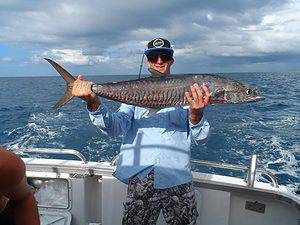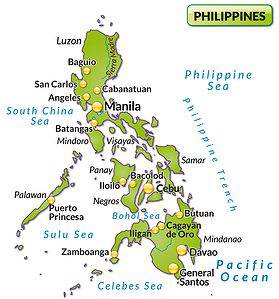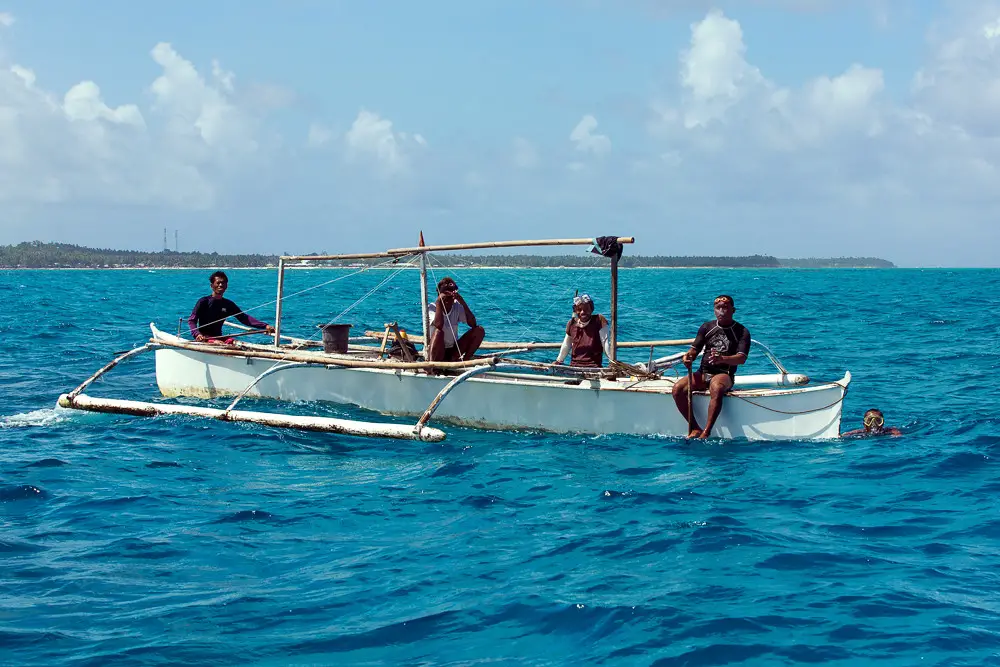Disclosure: Some posts contain affiliate links, which earn us a commission if you make a purchase through them. Positive Fishing © participates in various affiliate networks including the Amazon Services LLC Associates Program.
- With over 7,100 islands, the Philippines is considered the world’s marine biodiversity epicenter.
- Learn what fish to expect to catch when you go saltwater fishing in the Philippines.
- Learn when and where to go and have a family fishing vacation.
The Philippines has much to offer, especially regarding the variety and quantity of fish. In addition to the fantastic game fishing, the friendly, courteous people of the entire country are happy to be your guide.
Furthermore, communication is not a problem as most citizens can speak English.
Now, lend me 10 minutes of your time, and I will take you on a wonderful Philippine fishing trip through the knowledge and information of this article.
Top Fish to Catch in the Philippines
How diverse are the Philippines? Of the 34,300 fish species cataloged in FishBase, 3,125 can be found in the Philippines. That’s the reason why the Philippines is listed in the top 10 countries with the largest variety of marine fish species.
Offshore Fish in the Philippines

charter off the coast of Siargao
The Philippines is strategically located in the Pacific migration path of major pelagic fish. According to the UN-FAO, in 2019, the country’s commercial fishing industry produced over one million metric tons of fish.
Don’t get too concerned regarding the commercial fishing industry; there’s a lot of fish in the country!
Offshore fishing and game fishing are not as popular as in other countries. When you arrive and go fishing, it’s likely to be very easy to book a charter boat at a very reasonable price.
These are the offshore fish you can expect to catch in the Philippines (with the local name):
Billfish (Malasugi)
- Black marlin
- Blue marlin
- Broadbill swordfish
- Sailfish
- Striped marlin
Mackerels
- Indian mackerel (Alumahan)
- Spanish mackerel (Tanguigue)
Tuna (Barilis / Bodboron)
- Dogtooth tuna
- Frigate tuna
- Mackerel tuna
- Skipjack tuna
- Yellowfin tuna
Others
- Dolphinfish (Dorado)
Inshore Fish In The Philippines
With over 36,289 kilometers of shoreline littered with tidal flats and shallow reefs, the Philippines has a place for every sport fisherman. Some of the common inshore fish caught are:
- Bigeye scad (Matang baka)
- Giant Trevally (Talakitok)
- Rabbitfish (Kitong)
- Parrotfish (Molmol)
- Grouper (Lapu lapu)
- Snappers (Maya maya)
- Surgeonfish (Labahita)
- Barracuda (Rompi)
- Several species of wrasse
Where To Go Fishing In The Philippines?

When traveling to the Philippines, you should always consider your arrival terminal as international airports are well distributed on the country’s major islands: Luzon, Visayas, and Mindanao.
Note: You should make sure you book the correct flight destination. Some research is necessary to ensure you fly to the correct domestic airport once you arrive. The Philippines covers a wide area and is a large country with many islands.
Luzon
Ninoy Aquino International Airport is your gateway to the country’s main island, Luzon. From there, you have two options.
First, you can travel north to Subic Zambales. While there are many fishing charters in Subic, we suggest you try going with local fishermen in their traditional fishing grounds and be ready for a tuna frenzy. If you’re dying to catch dolphinfish, head to the northernmost part of Luzon on the island of Batanes.
Your second option is to go south to Batangas. Considered the epicenter of marine diversity, be ready to hook various fish, especially its signature catch – the Spanish mackerel.
Visayas
If you want to go fishing 10 minutes after landing at the airport, consider the Visayas islands through the Mactan-Cebu International Airport.
Fishing charters are just a short taxi ride away, and the Mactan Channel will be your main fishing ground. Spanish mackerel and dogtooth tuna are the common species caught here.
Given that the Visayas island is a tourism highway, try to explore other areas outside Cebu, like Leyte, Bohol, Dumaguete, and Siquijor. All these destinations are just a one hour catamaran ride from Cebu harbor.
Mindanao
Mindanao is considered the country’s fruit basket. But for us sport fishermen, Mindanao is synonymous with paradise, as its deep trenches are a part of the Pacific pelagic migration path.
Aside from being the hometown of our world boxing champion and Senator Manny Pacquiao, General Santos City is also the country’s tuna capital.
Just go to the fish port, and you will see tenders unloading gigantic yellowfin tunas. The single-day haul of over 25 metric tons of tuna displayed at the City’s Tuna Festival in 2014 earned a place in the Guinness Book of Records as the world’s largest fish display.
But here’s the “catch” when fishing in General Santos City. While the quantity of fish you will catch is still excellent, unfortunately, the fish’s size is reducing yearly—an indicator of overfishing pressure in the Philippines.
Siargao Island, Surigao
Siargao Island is located east of the Philippines, just south of the central belt, with several category five hotel resorts.
Siargao Island is the Philippines’ hot spot for surfing and big game fishing. In 2019, Siargao was voted the best island in the world by Conde Nast Traveler magazine readers! Game fishing competitions are held every August along the city’s coastal waters.
Siargao has great fishing for yellowfin tuna, skipjack tuna, jack, giant trevally, dorado, and marlin species. The best time to fish is between March and May. Siargao is most famous for its sailfish!
Dorado can also be caught from August to November using trolling methods.
You can hire a local guide on the island, and a large range of professional gear can be hired.
Lake Caliraya, Laguna
Lake Caliraya is a man-made lake in Lumban, Cavinti, and Kalayaan municipalities in Laguna province. The lake is best known for its largemouth bass population but is home to many other species, including the striped snakehead.
Located around 2 to 3 hours southeast of Manilla, it is a popular destination for water-based vacations for locals.
The bass are plentiful, and with fish approaching over 10 lbs, the bass can be considered to be a good size to catch and eat while guaranteeing good sport.
Other Philippine Game Fishing Locations
As in most places worldwide, the best places for offshore game fishing in the Philippines can be found in most of the least accessible places around the country.
Some of the better recognized are San Vicente (Cagayan Valley), Calatagan & Ambil (Batangas), Laiya (Batangas), Port Pilar (Siargao), and Dingalan (Aurora). However, getting to these locations requires more research and some local knowledge.
When To Go Fishing In The Philippines?
The Philippines is tropical, and fishing conditions are generally calm most of the year round. However, you must be aware of the monsoon seasons and try to avoid these times if possible.
While you can still go fishing, many of the boat charters may not be running on certain days if the weather is extreme.
Running from June to September, the southwest monsoon affects the country’s western coast (like Subic, Zambales, and Batangas). Usually, the northeast monsoon follows from October to January and affects the eastern part of the country (not to mention it is also the typhoon season).
What Are The Best Fishing Methods To Catch Fish In The Philippines?
There are many methods used in sport fishing in the Philippines, such as:
- Trolling
- Jigging
- Popping
- Fly fishing
While you are in the Philippines, you can also try using more traditional local fishing tactics which are proven to be effective, such as:
- Hook and line
- Multiple hook and line
- Jigger (very effective for squids)
Note that most of these rigs are baited with unique baits, and you will be surprised what locals commonly use for bait, such as squid skin, hermit crab, or earthworm for reef fish, and small live fish for big pelagics.
How To Book A Fishing Trip In The Philippines?

in knowing the best locations
Booking nowadays is relatively easy as it can be done digitally in the comfort of your home. However, do not ever make full payment before your fishing trip. The usual practice is a 10 to 20% down payment, which would suffice for your reservation and pay the balance after the trip.
It would be best to visit Sailfish Bay Surf and Fishing Lodge for big game fishing in Siargao. This is one of the best in the Philippines!
I recommend the 25-footer powerboat of Dominique’s Charters for fishing charters in Batangas. This boat is ideal for group fishing as it can accommodate up to 8 persons.
If you are in Cebu, you should try fishing in our traditional outrigger boat called “Banca” with Samsa Charters. You can go deep-sea fishing, trolling, or bottom fishing with them. And what’s best, all you need to do is get on board, as the fishing equipment, bait, snacks, and drinks are already included in the package.
If you’re uncomfortable fishing on a small boat, you can opt to go with Samsa Charters’ power catamaran.
These boats have more modern onboard amenities (like a toilet, chart plotter, and digital instruments like a depth sounder and a fish finder). They will add more comfort to your fishing vacation, especially if you want to include your kids or spouse.
For the entire family, my personal choice where you can enjoy both fishing and a family retreat is at the Busuanga Bay Lodge on the resort island of Palawan. Line fishing in the bay or half-day / full-day fishing excursions can be booked. The resort is more of a family holiday with fishing as an add-on extra.
Finally, I recommend the Porte Verde Resort at Cavinti if you plan to go bass fishing. It’s a beautiful resort that offers 5-star accommodation and provides various fishing opportunities, including boat and gear rental. For 600 pesos/hour, the cost includes unlimited bait.
Philippine Fishing Regulations
There is no specific law that governs sport fishing in the Philippines. However, policies are being implemented to conserve the country’s fishery.
Some policies include endangered species protection (the fish in the “top fish to catch section” are not classified as threatened or endangered) and establishing fish sanctuaries and marine reserves wherein sport fishing is strictly prohibited.
It’s highly advisable to talk with your local fishing guide about the do’s and don’ts in fishing, as there may be a slight variation in policies between fishing areas.
Your Key Takeaways On Why To Visit The Philippines
As I mentioned, Filipinos take pride in the locales as we always care for all your fishing-related needs. That’s how hospitable Filipinos are!
Your second takeaway is that you can do other things in the Philippines. Being a tourist country, there’s much to see in this tropical nation, both on land and underwater.
And lastly, your final takeaway is the value for money. The purchasing power of foreign currencies in Philippine goods and services is far greater than in other countries.
Signing Out
I hope that this article on the Philippines was useful and informative. You can read more articles on fishing vacations in other countries, including Australia, an angling paradise with similar species and friendly people.
Lastly, if you are an angler who loves fishing for sailfish, check out my article on fishing in Guatemala, the legendary destination for these magnificent fish.
- 5 Best Fishing Bags For Getting Your Gear Organized - January 13, 2025
- 4 Essential Surf Fishing Rigs - January 11, 2025
- How To Know The Sex Of A Fish You Have Caught? - December 9, 2024
